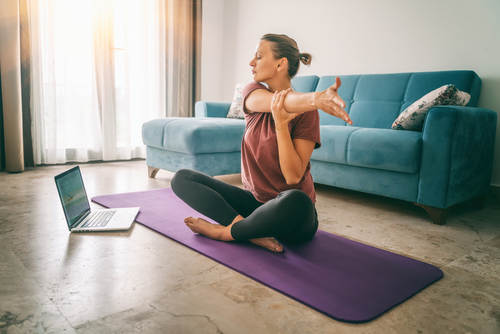Varicose veins are often painful and hard to manage, particularly if you like to exercise regularly. The unique strain these veins put on your body can make some exercises out of bounds for you. However, other activities may help manage your pain. The following exercise guide will provide you with the important information you need to exercise with varicose veins safely.
WHY EXERCISE CAN HURT WITH VARICOSE VEINS
Varicose veins often cause pain because of the added pressure they put on your legs. When you exercise, this pressure can increase and cause even more pain. Exercise causes increased pressure because it forces your muscles to contract. This, in turn, puts more pressure on the veins in your legs, which can cause them to bulge and become even more painful. Additionally, your varicose veins may make it difficult to move around and participate in some exercises.
However, not all exercise is bad for varicose veins. In fact, some exercises may actually help reduce the pain you’re experiencing. The key is to find the right balance of activity that works for you.
WHAT ARE THE SYMPTOMS OF VARICOSE VEINS?
Varicose veins often manifest through a variety of noticeable symptoms, primarily in the lower legs.
- Prominent Veins: The most visible sign is swollen, twisted veins that often appear just beneath the skin’s surface.
- Leg Discomfort: Many individuals experience a feeling of heaviness or fullness in their legs, often accompanied by aching pain. This discomfort tends to worsen with prolonged standing or sitting.
- Skin Changes: You might notice changes in skin color, including darkening or discoloration, medically known as hyperpigmentation.
- Swelling and Inflammation: Areas around the affected veins can become swollen or inflamed, and redness may be apparent.
- Muscle Issues: Nighttime cramps or a general sense of restlessness in the legs are common complaints.
- Prolonged Healing: Cuts or injuries on the legs may take longer to heal, indicating potential circulatory issues.
- Ulceration: In severe cases, ulcers can develop around the ankles, which require medical attention.
These symptoms not only cause physical discomfort but may also affect your daily activities. Recognizing these signs early can be crucial in seeking timely treatment.
UNDERSTANDING VARICOSE VEINS: CAUSES AND RISK FACTORS
Varicose veins stem from chronic venous insufficiency, a condition where the valves that help return blood from your legs to your heart fail. This failure leads to retrograde flow or pooling of blood in the veins, resulting in increased pressure and an array of symptoms, including the pain exacerbated during physical activity.
Key Risk Factors
Several risk factors can increase the likelihood of developing varicose veins:
- Inactivity: Sedentary lifestyles can contribute to poor circulation.
- Prolonged Standing: Standing for extended periods can strain the veins.
- Age: The risk increases with age as veins lose elasticity.
- Genetics and Family History: A family history of varicose veins can predispose individuals to the condition.
Lifestyle choices and general physical activity also play a significant role. While exercise is essential for overall health, certain activities might exacerbate symptoms, making it essential to find a balance that promotes circulation without causing additional discomfort.
WHAT EXERCISES ARE SAFE FOR VARICOSE VEINS?
There are a few different types of exercises that are safe for varicose veins. These include:
- Swimming
- Walking
- Bike Riding
- Yoga
- Stationary Bike or Elliptical
Doctors typically ask that patients with varicose veins perform at least a handful of the above-mentioned exercise routines to provide the most relief for varicose veins. Some of these exercise types do have additional benefits as well as things to stay away from.
Keep in mind, these exercises for varicose veins are designed to relieve pain; varicose veins will not go away with exercise. Getting rid of varicose veins requires in-office treatments. However, the right regular exercise can improve blood circulation and prevent varicose veins from forming.
LIFESTYLE MODIFICATIONS TO MAKE EXERCISE MORE COMFORTABLE :
To effectively manage varicose vein symptoms, consider incorporating a range of lifestyle changes. Start with education—understanding your condition is crucial and can guide you in making informed decisions.
- Healthy Diet: Focus on maintaining a balanced diet that supports vascular health. Incorporate plenty of fiber-rich foods to improve circulation and help control weight, reducing the strain on your veins.
- Appropriate Footwear: Choose shoes that provide good support and avoid high heels, which can exacerbate symptoms over time. Proper footwear can make a significant difference in comfort and symptom management.
- Address Risk Factors: Obesity is a notable risk factor that can worsen varicose veins. Aim to manage your weight through diet and regular exercise to alleviate pressure on your veins.
By combining these lifestyle modifications with regular exercise, you can take a proactive approach to managing varicose vein symptoms and maintaining overall vascular health.
Read on to learn the best exercises for varicose veins.
Swimming
Swimming and aquatic therapy can provide low-impact cardiovascular exercise that will help improve your circulation. Swimming is often cited as being one of the best exercises for people with varicose veins. This is because swimming provides a low-impact workout that doesn’t put too much strain on your legs. It also won’t place excessive stress on your veins or cause excessively high blood pressure.
Additionally, the water can provide gentle resistance that can help improve your circulation. This is great for your body as a whole. However, it’s important to avoid swimming in extremely hot water, as this can cause your veins to dilate and worsen your condition.
Try these varicose vein-safe pool exercises:
- Swimming laps – Actively swim back and forth the length of the pool. You can try different swimming styles like butterfly, breaststroke, and backstroke.
- Lift water weights – Use a gallon jug underwater or purchase some waterproof water weights. These can help you improve your muscle tone without the same stress on your veins as a land workout would cause.
- Run in the water – Jog in the shallow end of your pool to get in some low-impact cardio. If this is too hard, move into deeper water to make it a little less intense. Just make sure you can still touch the bottom.
- Bicycle your legs – It is what it sounds like. Grab onto the side of the pool to keep you stable and start moving your legs like you are on a bike.
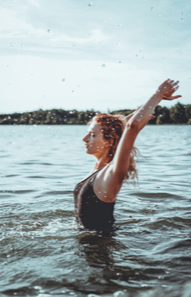
Walking
Walking is a low-impact exercise that can help improve your circulation without putting too much strain on your legs. This makes it perfect for people with varicose veins. Additionally, walking is a great way to get some gentle exercise while also enjoying the outdoors.
Walking regularly is a highly beneficial habit. If you get no other form of exercise, start by incorporating a 10-15 minute walk into your day. Walking is a low-impact exercise that also helps improve circulation. Additionally, when you walk daily, you may also experience overall improved moods, maintain a healthier weight, and have less overall pain.
Just be sure to avoid walking in extremely hot weather, as this can cause your veins to dilate and worsen your condition.
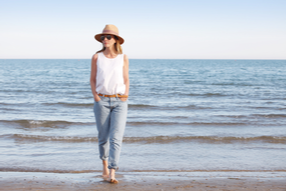
Bike Riding
Bike riding is another low-impact exercise that can help improve your circulation. Biking, or cycling, on an easy road or low-impact trail can stimulate blood flow in your legs, strengthen your calf muscles, and reduce chronic pain from venous insufficiency.
Benefits of Stationary Cycling for Varicose Veins
Stationary cycling offers a controlled environment that makes it easier to focus on improving circulation without the impact of outdoor conditions. Here’s how to get the most benefit:
- Adjust the seat to a comfortable height to ensure proper posture and optimize your workout.
- Pedal at a moderate pace, making sure each revolution is smooth and complete. This helps in promoting effective blood flow and minimizes strain.
- Start with 5-10 minutes of cycling and increase the duration gradually, as advised by a physical therapist. This gradual progression prevents overexertion and allows your body to adapt.
Additionally, bike riding can be a great way to get outdoors and enjoy the fresh air, lose weight, and alleviate stress. We recommend using compression stockings for added benefits while biking.
Just like with walking, avoid biking in extremely hot weather, as this can cause your veins to dilate and worsen your condition.
If getting outside is too hard on your veins, try this alternate approach. We’ll call it “air cycling.” Lay on your back and raise your legs in the air. Bend them in the same formation you would if you were actually riding a bike. Kick your legs out one at a time, mimicking the movement of pedaling. This has another added benefit of helping blood flow back to your heart!
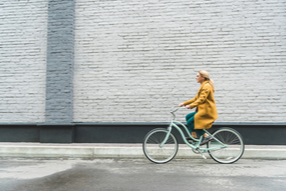
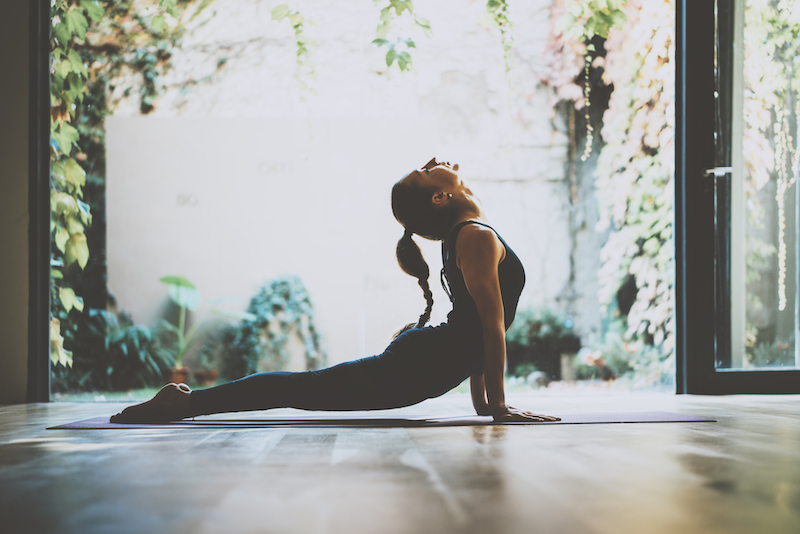
Yoga
Yoga is an overall customizable, low-impact, and highly beneficial type of exercise for your health. Don’t let the stereotypes of yoga gurus get in your way of experiencing the many benefits that yoga can offer, whether you’re young or young at heart. Establishing a routine yoga practice will help you improve your circulation, statically strengthen your muscles, improve your self-awareness, reduce pain from vein conditions, and much more.
There are many types of yoga available, ranging from restorative to power yoga. We recommend trying out a few to decide which type of yoga feels best for you. You may wish to join a class at a studio to be led and directed by a teacher. If this doesn’t seem comfortable or doable for you, many pre-recorded and live classes are available online.
A word of caution, some forms of yoga, like hot yoga and Bikram, may agitate varicose veins because of the high heat. We recommend practicing nonheated yoga for this reason.
Don’t Over Do It
Feel free to adjust your exercise routine to include these simple exercises and tweak their intensity to ensure that you do not experience excessive strain. The moment that you feel sharp pains during a workout, contact your doctor right away, as this may mean something else is wrong with your veins.
Exercises to avoid with varicose veins
Some of the most commonly asked questions about exercise for varicose veins:
- Can exercise worsen varicose veins?
- Can anything help varicose veins?
- Do squats help varicose veins?
- Does exercise give you varicose veins?
While many exercises will help with varicose veins, other exercises are more problematic and may make the situation worse. Over time, those already at high risk can develop varicose veins from working out. In particular, high-impact movements and routines can exacerbate the veins in your legs and worsen their pain. Here are a few exercises you should stay away from if you have varicose veins or if you’re at high risk of developing varicose veins:
Running and Jogging
If you were an active runner before you developed varicose veins, you should cut back on these activities. Both are often too high-impact for most varicose veins, but you may jog on softer surfaces to minimize this problem.
Weightlifting
While lifting weights may focus mostly on your chest and arms, the added pressure to your body can spread to your legs. That strain will often reduce the flow of blood out of your legs and may cause blood pooling. This issue could cause vein dilation or even trigger damage to your valves.
Some light resistance training may be beneficial, but you should be careful to maintain proper form and breathing patterns to avoid placing undue strain on your veins.
Leg-Focused Exercises
Any exercises that put excessive pressure on your legs and your abs may worsen your varicose veins. For example, crunches, squats, and sit-ups can create too much stress in your veins. You should also avoid doing planks or other postures that strain your abdominal muscles.
Some Types of Yoga
While some styles of yoga help manage varicose vein damage, other types may worsen your pain. For example, prolonged abdominal postures may decrease blood flow to your legs and worsen your varicose vein pain.
Protect Your Self from Worsening Your Vein Pain
If you want to perform these exercises in spite of your doctor’s warning, a pair of compression socks may minimize any pain. These socks will press against your skin and help blood flow more efficiently through your varicose veins. Make sure to wear these stockings if your pain worsens during any type of exercise.
WHEN TO SEEK MEDICAL ADVICE FOR VARICOSE VEINS
Varicose veins can often be more than just a cosmetic concern. It’s important to pay attention to your body’s signals and know when to consult a healthcare professional.
Symptoms that May Warrant Medical Attention:
- Persistent Pain or Discomfort: If your varicose veins are causing ongoing pain or discomfort, it’s crucial to get evaluated by a doctor.
- Changes in Skin Around the Veins: Be alert for signs such as skin discoloration, thickening, or inflammation near your varicose veins.
- Swelling and Heaviness: Noticeable swelling or a feeling of heaviness in your legs could indicate a more serious issue.
- Non-Healing Wounds or Ulcers: Look out for sores or ulcers near the varicose veins. These can be signs of venous insufficiency and require medical intervention.
- Bleeding or Bruising: If your varicose veins bleed easily or you notice bruising without a clear cause, seek medical advice promptly.
Why Professional Evaluation is Important
The symptoms associated with varicose veins can sometimes overlap with more severe health conditions such as blood clots or infections. Timely evaluation by a healthcare provider helps in ruling out these serious issues and provides guidance on managing your symptoms effectively.
If you experience any of these warning signs, don’t delay in seeking professional advice. Your health and comfort rely on timely intervention and proper management.
HOW PHYSICAL THERAPY CAN ASSIST IN MANAGING VARICOSE VEINS
Managing varicose veins effectively can significantly enhance your quality of life, and physical therapy plays a crucial role in this process. Here’s how:
1. Compression Support:
Physical therapists are key in recommending and aiding the use of compression stockings. They ensure these garments fit well and are used consistently, which helps in reducing vein swelling and improving blood circulation.
2. Lifestyle Considerations:
A major aspect of managing varicose veins is adopting healthier lifestyle choices. Physical therapists provide valuable education on balanced nutrition, choosing supportive footwear, and identifying risk factors such as obesity that could exacerbate the condition.
3. Encouraging Regular Physical Activity:
Staying active is vital for promoting normal blood flow and reducing vein discomfort. A physical therapist can tailor an exercise program specifically for you, incorporating activities like walking and resistance exercises to enhance circulation.
4. Prescribing Targeted Exercises:
Specific exercises tailored to strengthen the lower body and improve blood flow are an essential part of managing varicose veins. Physical therapists can design exercise routines that focus on improving leg strength and flexibility, addressing the discomfort associated with varicose veins.
By integrating these strategies, physical therapy provides a comprehensive approach to managing varicose veins without surgical intervention, promoting healthier circulation and reducing symptoms.
VASCULAR SURGERY MAY BE YOUR ANSWER
As you can see, exercise is a complex process in varicose vein management. So if you find that you cannot perform any exercise due to your varicose veins, please do not hesitate to contact us at The Vein Centre right away to get the help that you need. Our vascular surgery professionals will assess your situation and come up with a treatment method — including surgery — that can help you recover. We look forward to your call.


